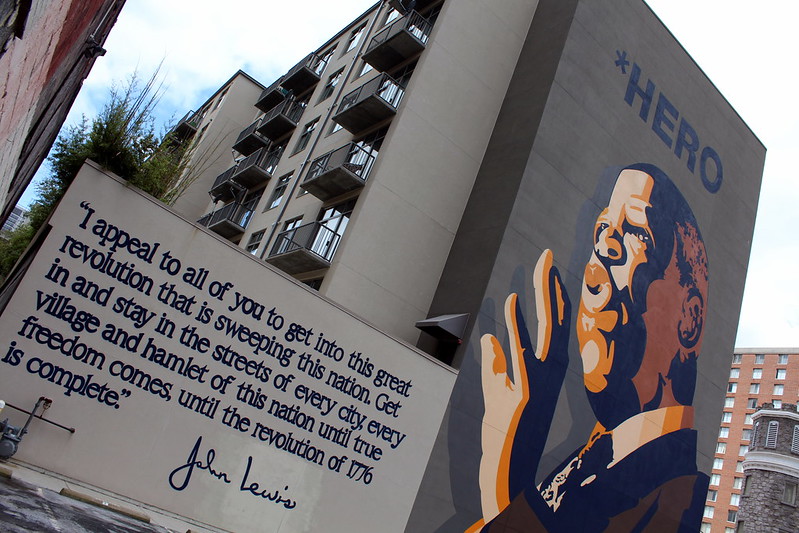John Lewis, who died last week, will shine in American history as a great hero who fought valiantly for the rights of African-Americans in the 1960s with a vision of the 1960s.
When he was 16, Lewis went to a library to get a membership card. He was denied the card because the library was only for white people. When he was outside home and would become thirsty, the boy from Troy, Ala., had to scamper up and down looking for a water fountain marked for the “negroes.” And we know what happened to him on that “Bloody Sunday” in March 1965. When Lewis and his fellow civil rights marchers reached the Edmund Pettus Bridge in Selma, Ala., a white police force swooped down on them with brutal force and cracked open Lewis’s skull with their billy clubs. It took him six days in a hospital to get his fractured skull repaired and somewhat healed.
In the mid-20th century America no struggle was more urgent than fighting against the grave justices suffered by African-Americans: lynching; segregation in housing, schooling and social life; job discrimination; and smoldering white hatred. Led by the legendary civil rights leader Martin Luther King Jr., Lewis and hundreds of thousands of other black and white Americans kept marching and agitating for racial justice until they shook American conscience, changing America forever. The historic movement got the blacks their civil rights and voting rights, most kinds of jobs, desegregated schools and housing, and established, legally, social equality across America.
The success of the struggle overall was breathtaking and far-reaching, as Congressman Lewis described it few years ago.
“Now we have black and white elected officials working together,” he said. “Today, we have gone beyond just passing laws. Now we have to create a sense that we are one community, one family. Really, we are the American family.”
I have a problem, though, with his last two sentences. I think the acclaimed civil rights leader got a little carried away there.
Is America, really, “one community”? Are we all one “American family”?
Lewis’s mentor, Dr. King, had the “dream” that “one day … in Alabama little black boys and black girls will be able to join hands with little white boys and white girls as sisters and brothers.”
Nearly six decades after the historic speech that Dr. King delivered in Washington on August 28, 1963, how many “little black boys and black girls [are] able to join hands with little white boys” in Alabama or anywhere else in America?
America has not become, and I doubt it ever will be or need to be, a single community, let alone a single family. The last census showed that 97.7 percent of American white wives have white husbands. A 2013 American Values Survey found that the social networks of white Americans are nearly 91 percent white. Blacks and Latinos have more diverse social networks, but they too are socializing mostly with people of the same races.
Most people are marrying and socializing, happily and voluntarily, within their racial and ethnic communities because they value their particular communal identities. Those communal ties bring them happiness and a sense of security. They lend meaning to their lives.
For all its breathtaking accomplishments in social, political and fields, the Civil Rights Movement picked one apparently unattainable goal: eliminating racial and ethnic markers and values. The black communal subculture pulsates with life and vigor as it ever did. So do Jewish, Muslim, Hindu, Hispanic and other cultural communities. Today not many African-Americans would want to sacrifice their racial or cultural identity and cultural pattern for a college admission, a business contract or job (unless maybe he is a Clarence Thomas!)
Why did the civil rights leaders, then, want to renounce the native cultural space of “little black boys and black girls” and blend them into the mostly white American social mainstream? They did so because their worldviews were shaped by the classical concept of nationalism, which privileged national communities and national cultures over religious, ethnic and racial ones. This is where Dr. King and Malcolm X differed. Malcolm X wanted to sustain and nurture the blacks’ cultural niche, while eliminating all kinds of inequities and discrimination against African-Americans.
It is apparent by now that nationalism, as it was viewed through the 1950s and 1960s, sought to replace people’s religious and ethnic values and cultures with national “high cultures,” based on humanism. That notion of nationhood has since faced challenges everywhere. Religious and ethnic values and agendas are shaping politics and government policies all over the world outside the West – in Malaysia, Myanmar, Sri Lanka, India, Pakistan, Iran, Iraq, Turkey, and so on. Nations in Europe, the birthplace of modern nationalism, have all but jettisoned national sovereignty and boundaries and blended into the European Union, held up by their more natural root: race. The refreshing and ennobling thing about the revival of Europeans as racial category (The Turks call the EU a “white-Christian club”) is that their white, Germanic tribal roots no longer breed hostile vibes they used to only eight decades ago. The Holocaust, realization of the futility of the colonization of brown and black peoples’ lands, etc., have mollified Europeans’ racial affiliation.
In the early 1970s, when I lived in London, mocking the lifestyles of Bangladeshi immigrants in Tower Hamlet was a pastime among many white Londoners. In 2016 when I bumped into a news blurb on the Internet announcing the election of a Bangladeshi native, Sadiq Khan, as mayor of the capital of what used to be the British Empire (of which Bangladesh was a colony), I was mesmerized. Bangladeshi natives made up 0.7 percent of London’s population, and the news bulletin told me how deeply has race consciousness eroded among white Britons.
On visits to the Parliament Square, I used to see clusters of mostly white tourists gazing admiringly at the statue of Winston Churchill (whose political eloquence and literary genius I extolled in my college years). I could not have dreamed ever of seeing white Londoners attacking Churchill’s stature there, as they did xxx. Put in a box to protect it from anti-racist demonstrators, some of them daubed the box with the graffiti: “Racist inside.” Then in Prague, white participants in another anti-racist rally sprayed Churchill’s stature in red graffiti with the words “Byl rasista,” meaning, “He was racist.” In 1999 then British Prime Minister Margaret Thatcher had unveiled Churchill’s statue in the Czech capital.
There are pockets of racism and Islamophobia in Europe, but the white mainstream across Britain and the Continent has mostly rubbed off the malignancy that once oozed from its racial and communal affinity.
That should be a lesson for the rest of us. We should proudly nurture our affiliation with our naturally evolved cultural communities: national, religious, ethnic, tribal, and yes, racial. Our sense of belonging to these communities give us our lives their meaning and fulfillment. The challenge today is to develop social and political models that erode malignancy from our communal belongings, as Europe apparently has.
If I were John Lewis’s speechwriter, I would have replaced “one community, one family” with “a nation of mutually supportive communities.”
- Mustafa Malik is a Washington-based analyst of international affairs.


